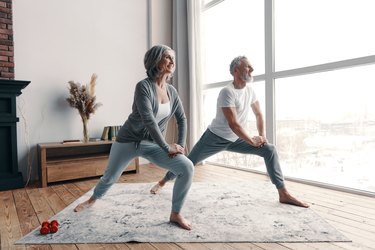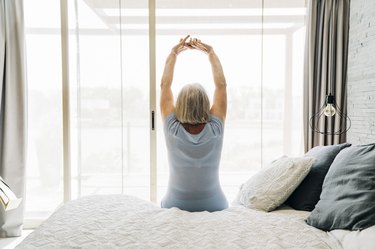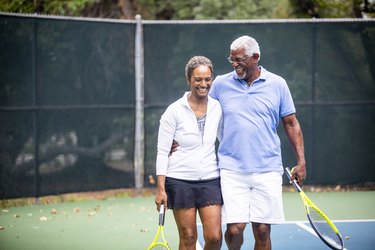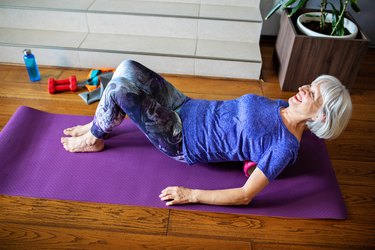

Feeling a wee bit wobbly on your feet as you age? You're not alone. Balance-related issues are one of the most common health complaints among older people, according to the National Institute on Aging (NIA).
But feeling unstable on your feet can have major consequences. Good balance is necessary to carry out even the most basic daily activities (think: walking, climbing stairs, getting in and out of a car, etc.), so if you struggle to stay steady, you're less likely to maintain independence in older age.
Video of the Day
What's more, balance problems are a primary cause of falls in the elderly, per the NIA. Indeed, one in four older Americans will take a tumble every year, and a fifth of these falls will lead to a serious injury, such as broken bones or a head trauma, per the Centers for Disease Control and Prevention.
But why does our balance break down as we go gray?
Here, Grayson Wickham, DPT, CSCS, founder of the Movement Vault, explains why we tend to teeter more in our twilight years, plus ways to prevent it (because bad balance doesn't have to be inevitable).
6 Reasons Balance Worsens With Age
1. Loss of Muscle Mass
As you age, you'll slowly start to lose muscle mass (a process known as sarcopenia that begins as early as age 30).
Sarcopenia occurs due to a confluence of age-related factors including increased inactivity and hormonal changes, Wickham says.
Problem is, "when you lose muscle mass and strength, your ability to maintain strong and stable joints decreases," Wickham says. "And having stable joints is one of the key factors when it comes to having good balance," he says.
"You need to be able to keep your joints in a stable position while both moving and not moving," Wickham says. So if you lack joint stability, your joints may "buckle," which you will experience as poor balance, he says.
2. Decline in Joint Mobility/Flexibility
As we know, healthy joints are essential for equilibrium. But your joints tend to take a hit as you age. Very often, this is due to a more sedentary lifestyle in your senior years.
"If you add up all the time that you are either sitting or lying down during your average 24-hour period, you will most likely be shocked," Wickham says. "Most people are only moving for about one to two hours of their day," he says.
But here's the thing: "When you are not moving, you not only lose muscle mass, but also joint mobility and flexibility," Wickham says. And this is bad news for balance.
That's because when you sit for prolonged periods of time, your muscles and joints become tight. And eventually, they won't be capable of moving as well.
As a result, these tight, restricted joints won't be able to activate and contract specific muscles or achieve larger ranges of motion, which all help you maintain your balance, Wickham explains.
What's more, arthritis and/or bone-related diseases (like osteoporosis) — which are more common in older folks — can lessen joint mobility too.
3. Diminished Proprioception
As you become less physically active in older age, your proprioception (the technical term for body awareness) will decrease too, Wickham says.
Important for aging and balance, "proprioception is the ability to sense where your joints and body are at all times," he says.
"You have nerve receptors in and around your joints that send information to your brain and nervous system," Wickham says. "This means that your brain and nervous system know where your body is both consciously and subconsciously (which can also be thought of as coordination)," he explains.
"When you age, and don't move often, these nerves receptors don't work as well, which leads to diminished body awareness," Wickham says.
"And when you don't have a good sense of where your body and joints are, it makes it difficult to maintain your balance," he says.
4. Slowed Reflexes
Reflexes — involuntary or automatic reactions that your body does in response to something — play a pivotal part in controlling coordination, balance, posture and movement.
For example, if you trip on a crack on the sidewalk, your hands and arms will automatically stretch out to break your fall and your muscles will tighten to reduce injury, according to the University of Rochester Medical Center.
But reflexes and reaction times tend to slow in your golden years, primarily due to inactivity and age-related degeneration of the nervous system, Wickham says.
Indeed, as you age, the areas of the brain responsible for motor control lose cells and shifts in nerve fibers slow down electrical impulses, per the University of Rochester Medical Center.
"In addition to these factors, your overall level of health also plays a role," Wickham says. Your level of inflammation, insulin and glucose regulation and other medical issues can contribute to chronic health conditions that may lead to deterioration of your nervous system and, as a result, cause delayed and/or diminished reflexes, he says.
5. Degeneration of the Vestibular System
Your vestibular system (the part of the inner ear involved in balance) is a big factor when it comes to maintaining a healthy equilibrium, Wickham says.
Just like your nervous system degenerates as you age, your vestibular system can also deteriorate in your twilight years and is similarly impacted by other health-related biomarkers (such as inflammation, insulin and glucose regulation, etc.), Wickham says.
That means "the better your overall health is, the better every system in your body will function, including your vestibular system," Wickham says.
6. Impaired Vision
Aging can affect your eyes. In fact, older age is associated with a higher risk for certain eye diseases, according to the American Academy of Ophthalmology (AAO).
But this shift in sight can blight your balance abilities.
"Most people rely heavily on their vision for balance," Wickham says. You can test this by standing on one leg with your eyes open. Next, try the same thing, but close your eyes. "It was most likely a lot more challenging to maintain your balance with your eyes closed," he says.
But when vision declines, it can impact things such as depth perception, sensitivity to contrast and night vision, which are all important factors when it comes to staying steady on your feet.
Tip
You can protect your peepers — and detect eye issues early on — by seeing an eye doctor for regular check-ups. Start scheduling routine eye exams by the age of 40 and plan to visit your eye professional for annual (or biannual) exams once you turn 65, per the AAO.
Other Signs of Balance Problems
In addition to feeling unsteady on your feet, here are additional symptoms that may signal impaired balance, per the NIA:
- Dizziness or vertigo (a spinning sensation)
- Falling or feeling as if you are going to fall
- Lightheadedness, faintness, or a floating sensation
- Blurred vision
- Confusion or disorientation
5 Exercises to Improve Balance as You Age
Wondering how to improve your balance? While certain aspects of aging are beyond our control, there are things you can do to keep balance issues at bay.
For one, you can prevent (and even fix) tight muscles and joints before they become too limited and impair your balance, Wickham says. Specifically, moving more often throughout your day and performing active stretches and mobility drills can help preserve balance, he says.
Likewise, you can reduce (and in some cases reverse) the forces of aging on your reflexes and coordination by prioritizing physical activity, according to the University of Rochester Medical Center.
The following movements and exercises are a great starting point to build balance-supporting foundational joint mobility, stability, strength and proprioception, Wickham says.
For the best balance results, do 1 or 2 sets of this routine three times a week.
And if you find you're feeling a little shaky, that's OK. It takes time to build balance. Simply hold onto a chair or wall until you feel sturdier.
1. Standing Hip Full Range Activation
"This is a great bang for the buck movement as it helps you improve your balance and hip joint mobility at the same time," Wickham says. "Your goal is to stand as still as possible [on one leg] while moving one of your hips through your absolute full range of motion," he says.
- Stand up straight while balancing on your left leg. You can hold onto support if needed.
- Bend your right knee, lifting it to a 90-degree angle.
- Flexing your right hip forward, rotate your hip out, bring your bent leg to the side and then extend your hip backward as far as possible without arching your lower back.
- Reverse the movement, circling your hip in the opposite direction (toward the front) until you return to the starting position.
- That’s 1 rep. Do 5 slow and controlled reps per side.
2. Single-Leg Romanian Deadlift
With your feet and ankles working to keep you steady, this movement will improve your single-leg balance while improving your hip mobility, proprioception and glute and hamstring strength, Wickham says.
- Stand on your left leg with your right leg slightly lifted.
- Hinging at your hips, push your hips back as far as possible until you feel a maximal stretch in the back of your left leg (hamstring) muscles as you seesaw your right leg up behind you for balance. Your upper body should be parallel to the ground.
- Engage your hamstring and glute muscles, while pushing your left foot into the ground, to move your hips back to a standing position.
- Do 10 slow and controlled reps per side.
3. Standing Hip Abduction
"This movement helps you improve your single-leg stability (on your non-moving leg) while strengthening and activating your gluteus medius muscle," Wickham says.
Your gluteus medius is monumental for good balance. So if it's weak, it can lead to an unstable hip, which is a precursor to poor balance, Wickham explains.
- Start by standing tall with your left foot firmly planted on the ground and your right foot lifted behind you. Try to remain as straight as possible without leaning over to either side.
- Flex your right foot and keep your leg straight as you lift it behind you on a diagonal.
- Hold this position for five seconds before bringing your leg back to the starting position. You should feel this working the side and back of your glute muscles.
- Do 10 slow and controlled reps per side.
4. Single-Leg Standing Ball Toss
"This exercise takes single-leg balance to the next level as you must concentrate on tossing and catching a ball all while maintaining a stable standing position," Wickham says.
- Stand with your left foot firmly planted on the ground and your right hip and knee flexed to 90 degrees.
- With your right hand, toss a ball straight upward 1 to 2 feet in the air. Try to catch the ball without moving your hand or arm or shifting your standing leg.
- Do 10 ball tosses per side.
5. Curtsy Lunge Reach
"This movement works on single-leg quadriceps strength and stability with a joint mobility bonus," Wickham says.
- Stand tall with your right foot firmly planted on the ground and your left foot slightly lifted behind you.
- While bending your right knee, hinge at your hips and push them back.
- Your right knee should track over the middle of your foot the entire time and should not buckle inward.
- Reach back diagonally with your left leg as far as you can, as if aiming for the back corner.
- Lightly tap your toe on the ground before bringing your back leg forward to the starting position.
- Do 8 to 10 slow and controlled reps per side.
Tip
“Focus on reaching your leg back and to the side as far as possible,” Wickham says. “When you do this, you are stretching out your hip external rotator muscles, including your glutes and piriformis, while also contracting them,” he explains.


